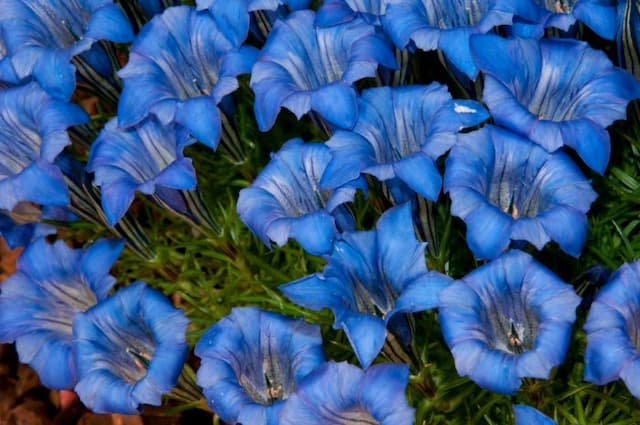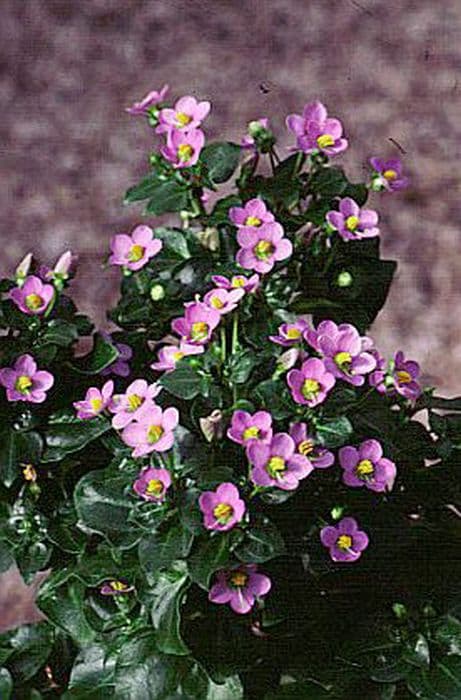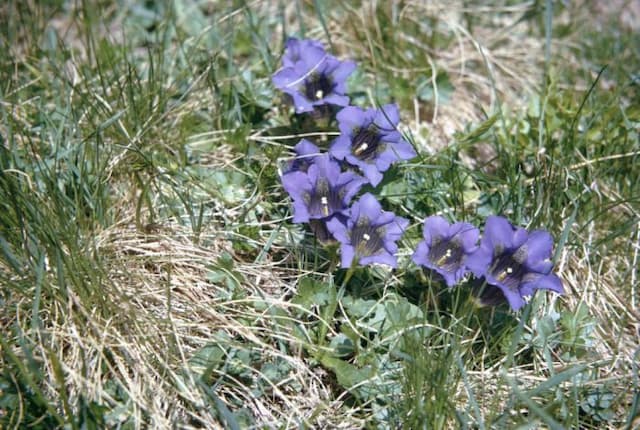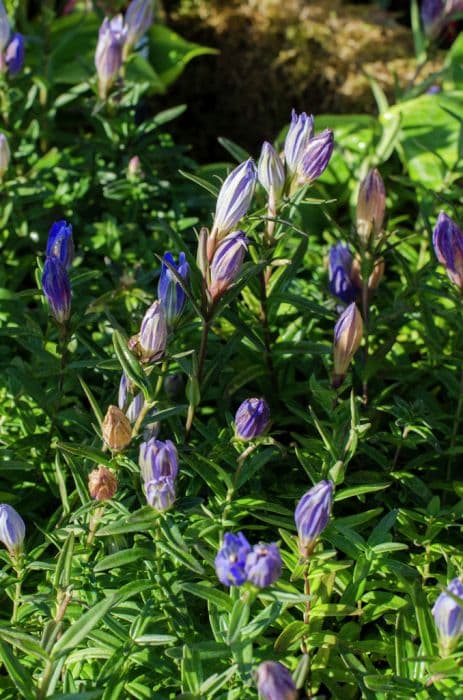Gentian Gentiana 'Eugen's Allerbester' (d)

ABOUT
Gentiana 'Eugen's Allerbester', commonly known as Gentian, has a distinct appearance characterized by its striking flowers and attractive foliage. The plant is noted for its trumpet-shaped blooms which exhibit a vibrant blue color, sometimes with spots or stripes of a deeper hue or contrasting color like white. The petals may have a frilly or ruffled appearance, adding to the plant's ornamental appeal. The foliage of Gentian is typically lance-shaped with a glossy green color, creating a lush backdrop for the stunning blooms. The leaves can grow in a rosette pattern close to the ground, or they might be arranged alternatively along the plant's stems, which can sometimes be upright or sprawling depending on the variety. Gentians generally flower during the late summer to fall, providing a late-season display of color in gardens and natural settings. The overall shape of the Gentian plant is neat and tidy, with a balanced growth that makes it an attractive addition to rock gardens, borders, or as a ground cover, depending on the growth habit of this particular cultivar. It's the allure of the deep blue flowers that is most captivating and often becomes a focal point for onlookers and garden enthusiasts.
About this plant
 Names
NamesFamily
Gentianaceae
Synonyms
Gentian
Common names
Gentiana 'Eugen's Allerbester'
 Toxicity
ToxicityTo humans
The plant commonly known as Gentian is not widely recognized as toxic to humans. These plants are generally considered safe, and some species within the Gentiana genus have had their roots historically used in herbal medicine, particularly as digestive tonics. Nonetheless, excessive ingestion of any plant material can lead to gastrointestinal discomfort or other non-specific symptoms due to the presence of plant compounds. It is still recommended to avoid consuming parts of this plant for which no information on edibility is available and to consult healthcare professionals if any adverse reactions are observed after ingestion.
To pets
Gentian is not commonly known to be toxic to pets. This plant is not listed among those that are typically hazardous to dogs, cats, or other domestic animals. However, as with any non-food plant, ingestion can potentially cause mild stomach upset in some pets due to the novelty and fiber content. If a pet shows symptoms of distress after ingesting this plant, such as vomiting, diarrhea, or unusual lethargy, it is advisable to consult a veterinarian.
 Characteristics
CharacteristicsLife cycle
Perennials
Foliage type
Deciduous
Color of leaves
Green
Flower color
Blue
Height
1 foot (30 cm)
Spread
1 foot (30 cm)
Plant type
Herb
Hardiness zones
4
Native area
Europe
Benefits
 General Benefits
General Benefits- Aesthetic Appeal: Adds vibrant blue or violet flowers to the garden, offering a striking visual display.
- Pollinator Attraction: Attracts bees, butterflies, and other beneficial insects, helping to pollinate the garden.
- Easy Maintenance: Once established, it requires minimal care aside from occasional watering and pruning.
- Cold Tolerance: Hardy in many climates, it can survive and even thrive in cooler temperatures.
- Versatility in Landscaping: Can be used in rock gardens, borders, or as a ground cover, adding texture and color.
- Drought Resistance: Adapted to withstand periods of low water availability, making it suitable for xeriscaping.
 Medical Properties
Medical Properties- Digestive Aid: Gentiana species have been traditionally used to help stimulate appetite and improve digestion due to their bitter compounds.
- Anti-inflammatory: Some compounds found in Gentiana species may have anti-inflammatory properties useful in reducing swelling and inflammation.
- Hepatoprotective: There is some evidence to suggest certain Gentiana species can help protect the liver and improve liver function.
 Air-purifying Qualities
Air-purifying QualitiesThis plant is not specifically known for air purifying qualities.
 Other Uses
Other Uses- Gentian's deep blue flowers can be used as a natural dye for fabrics, providing hues varying from blue to green depending on the mordant used.
- The plant's root extracts have been applied in traditional photography to create a blue tint on photographs, known as cyanotype.
- Gentian flowers are sometimes crystallized and used as unique, edible decorations for desserts and special dishes.
- The dried flowers can serve as a component in potpourris, offering a decorative look and a subtle fragrance to the mix.
- In floristry, gentian stems can be used to create stunning and long-lasting floral arrangements due to their vibrant color and sturdy stems.
- Gentian can play a role in companion planting, especially in organic gardening, to attract beneficial insects or repel pests due to its distinct scent.
- The plant’s extracts are sometimes used in the perfume industry as a fixative, to extend the longevity of a fragrance.
- Gentian leaves can be incorporated into paper-making for adding texture and visual interest in handmade paper crafts.
- Due to its bitter taste, gentian has been traditionally used to flavor ales and beers before the widespread use of hops.
- Gentian plants can be included in educational gardens or botany programs to demonstrate Alpine plant adaptations to students and enthusiasts.
Interesting Facts
 Feng Shui
Feng ShuiThe Gentian is not used in Feng Shui practice.
 Zodiac Sign Compitability
Zodiac Sign CompitabilityThe Gentian is not used in astrology practice.
 Plant Symbolism
Plant Symbolism- Endurance: Gentians are known for their ability to thrive in harsh, rocky environments, symbolizing strength and the ability to withstand tough conditions.
- Determination: The plant's determined growth, often against the odds, represents a never-give-up attitude and perseverance.
- Victory: In some traditions, gentians are associated with triumph and overcoming challenges, possibly due to their vibrant colors standing out in austere landscapes.
 Water
WaterThe Gentian plant requires regular watering to keep the soil consistently moist but not waterlogged. During the growing season, water thoroughly once the top inch of soil feels dry, approximately every 1 to 2 weeks, using about 1 gallon of water per plant each time. Adjust the amount based on weather conditions and the plant's location. In hotter, dryer periods, you may need to water more frequently. Over the winter, reduce watering but do not allow the soil to completely dry out.
 Light
LightGentians prefer bright, indirect light or partial shade. They thrive best when sheltered from the intense midday sun, so a spot that receives morning light and afternoon shade is ideal. Avoid deep shade, as too little light can hinder flowering and growth.
 Temperature
TemperatureGentians require cool to moderate temperatures, ideally between 50°F and 70°F. They can tolerate temperatures down to about 20°F but not prolonged periods of extreme cold or frost. Heat above 80°F can stress the plant, so provide a cooler, shaded spot during the hottest parts of the summer.
 Pruning
PruningPruning gentians is not generally necessary for health but can be done to maintain shape or remove dead and damaged stems. Prune in late winter or early spring before new growth begins. Cut back any spent flowering stems after bloom to encourage a tidy appearance and potentially a second bloom.
 Cleaning
CleaningAs needed
 Soil
SoilGentian requires well-draining soil with a mix of loam, peat moss, and sand to promote good drainage and aeration. The pH should be slightly acidic to neutral, around 5.5 to 7.
 Repotting
RepottingGentians, including Eugen's Allerbester, generally need to be repotted every two to three years to refresh the soil and to accommodate root growth.
 Humidity & Misting
Humidity & MistingGentians thrive in moderate humidity levels but do not require high humidity, making averagely moist air conditions suitable for Eugen's Allerbester without the need for additional humidity control.
 Suitable locations
Suitable locationsIndoor
Place in bright indirect light and cool temperature.
Outdoor
Plant in partial shade, sheltered from hot sun, in cool climates.
Hardiness zone
3-7 USDA
 Life cycle
Life cycleGentiana 'Eugen's Allerbester', commonly known as Eugen's Allerbester Gentian, begins its life cycle when seeds are sown in well-draining soil with exposure to cold stratification, which simulates winter conditions necessary for germination. After sprouting in spring, the seedlings develop into young plants with characteristic lance-shaped leaves and eventually form a compact, mound-shaped perennial. In its vegetative stage, Eugen's Allerbester Gentian focuses on foliage growth and root establishment, preferring full to partial sun and consistent moisture. The plant reaches maturity in a couple of years, during which it produces vivid blue, trumpet-shaped flowers typically in late summer to early fall, attracting pollinators such as bees and butterflies. After blooming, the plant sets seed, which can be dispersed by wind or captured for propagation. The Gentian enters a period of dormancy during winter, its foliage dying back, and then it resumes its growth cycle the following spring.
 Propogation
PropogationPropogation time
Spring-Early Summer
Gentiana 'Eugen's Allerbester', also known as Gentian, is frequently propagated through division, which is best done in the spring as the plant emerges from dormancy. To propagate by division, carefully lift the clump of gentian from the soil, ensuring not to harm the roots. Gently pull apart the plant into smaller sections, each with at least one growing point or bud. These divisions can then be replanted into prepared soil, spacing them about 12 inches (approximately 30 centimeters) apart to allow for growth. Water the new plants well and maintain consistent moisture levels as they establish. This method of propagation is effective as it maintains the genetic integrity of the cultivar and allows for quick establishment of new plants.









